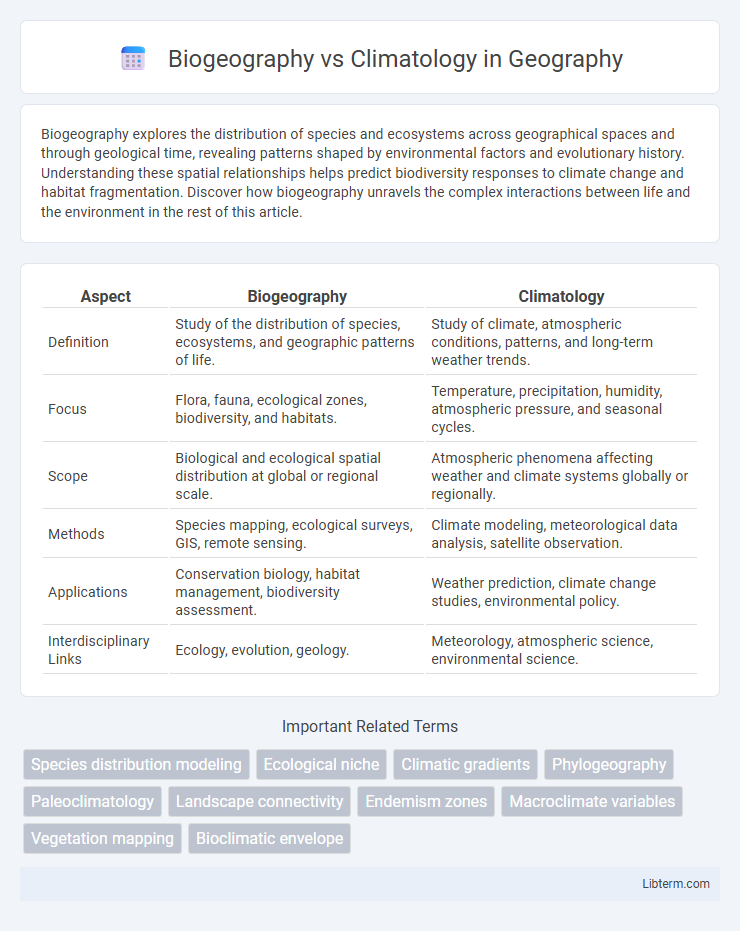Biogeography explores the distribution of species and ecosystems across geographical spaces and through geological time, revealing patterns shaped by environmental factors and evolutionary history. Understanding these spatial relationships helps predict biodiversity responses to climate change and habitat fragmentation. Discover how biogeography unravels the complex interactions between life and the environment in the rest of this article.
Table of Comparison
| Aspect | Biogeography | Climatology |
|---|---|---|
| Definition | Study of the distribution of species, ecosystems, and geographic patterns of life. | Study of climate, atmospheric conditions, patterns, and long-term weather trends. |
| Focus | Flora, fauna, ecological zones, biodiversity, and habitats. | Temperature, precipitation, humidity, atmospheric pressure, and seasonal cycles. |
| Scope | Biological and ecological spatial distribution at global or regional scale. | Atmospheric phenomena affecting weather and climate systems globally or regionally. |
| Methods | Species mapping, ecological surveys, GIS, remote sensing. | Climate modeling, meteorological data analysis, satellite observation. |
| Applications | Conservation biology, habitat management, biodiversity assessment. | Weather prediction, climate change studies, environmental policy. |
| Interdisciplinary Links | Ecology, evolution, geology. | Meteorology, atmospheric science, environmental science. |
Introduction to Biogeography and Climatology
Biogeography examines the spatial distribution of living organisms across ecosystems, emphasizing patterns influenced by environmental and historical factors. Climatology studies climate systems and atmospheric conditions over time, focusing on data such as temperature, precipitation, and seasonal variations. Both fields intersect by analyzing how climate impacts species distribution and ecological dynamics.
Defining Biogeography: Scope and Importance
Biogeography examines the distribution of species and ecosystems across geographic spaces and through geological time, highlighting interactions between biological diversity and environmental factors. It integrates ecological, evolutionary, and geological data to understand patterns of species richness, endemism, and extinction. This field is crucial for biodiversity conservation, habitat management, and predicting ecological responses to climate change.
Climatology Explained: Key Concepts and Applications
Climatology studies long-term atmospheric patterns and climate systems to understand variations in temperature, precipitation, humidity, and wind over time and space. Key concepts include climate classification, climate change, and the impact of greenhouse gases on global warming, which are essential for predicting weather trends and informing environmental policy. Applications of climatology span agriculture, urban planning, disaster management, and assessing the effects of climate variability on ecosystems and human health.
Historical Development of Biogeography and Climatology
Biogeography emerged in the 18th century through the works of naturalists like Alexander von Humboldt, who linked species distribution to environmental factors, laying the groundwork for understanding ecological patterns. Climatology developed during the 19th century with advancements in meteorological instruments and the establishment of systematic weather observation networks, enabling detailed analysis of climate zones and long-term atmospheric trends. Both disciplines evolved by integrating empirical data and theoretical models, shaping modern environmental science and contributing to ecosystem and climate change studies.
Methodological Differences in Biogeography and Climatology
Biogeography employs spatial analysis techniques such as species distribution modeling, ecological niche modeling, and geographic information systems (GIS) to study the patterns and processes affecting biodiversity across different regions. Climatology relies heavily on climate data analysis, atmospheric modeling, and long-term weather trend simulations to understand climate variability and change. The methodological divergence lies in biogeography's emphasis on biological spatial patterns and ecological factors, whereas climatology prioritizes physical climate dynamics and meteorological data.
Influence of Climate on Species Distribution
Climate plays a crucial role in biogeography by shaping species distribution patterns through temperature, precipitation, and seasonal variations that determine habitat suitability. Climatology provides data on climatic zones and microclimates, enabling predictions of species range shifts in response to climate change. Understanding these climate-driven influences helps explain biodiversity gradients and ecosystem dynamics across different geographic regions.
Human Impact: Climatology vs. Biogeographical Patterns
Human impact in climatology revolves around altering atmospheric conditions through greenhouse gas emissions, leading to global warming and extreme weather patterns. In biogeography, human activities disrupt species distributions and ecosystem dynamics by habitat destruction, invasive species introduction, and land-use changes. The interplay between climate change and biogeographical patterns highlights shifts in species ranges, altered migration routes, and biodiversity loss linked to anthropogenic climate effects.
Case Studies: Integrating Biogeography and Climatology
Case studies integrating biogeography and climatology reveal critical insights into species distribution shifts driven by climate change, exemplified by the poleward migration of marine organisms in response to ocean warming. Research on the Amazon rainforest demonstrates how alterations in precipitation patterns and temperature regimes influence biodiversity hotspots, affecting endemic species survival. Combining spatial analysis of habitat fragmentation with climatic models enables precise forecasting of ecosystem resilience under future climate scenarios, supporting conservation strategies.
Future Trends in Biogeography and Climatology
Future trends in biogeography emphasize the integration of advanced spatial modelling and remote sensing to predict species distribution shifts under changing climate scenarios. Climatology increasingly leverages high-resolution climate models and machine learning algorithms to enhance the accuracy of regional climate projections. Both fields converge in studying ecosystem responses to anthropogenic impacts, fostering interdisciplinary approaches for biodiversity conservation and climate adaptation strategies.
Conclusion: Bridging the Gap Between Biogeography and Climatology
Integrating biogeography and climatology enhances understanding of species distribution patterns in response to climate dynamics, providing crucial insights for biodiversity conservation and climate change adaptation. Advanced modeling techniques that combine ecological and meteorological data enable more accurate predictions of ecosystem shifts under varying climate scenarios. Strengthening collaboration between these disciplines fosters comprehensive strategies to address environmental challenges and promote sustainable management of natural resources.
Biogeography Infographic

 libterm.com
libterm.com